Sriranga Sadguru
(A Short Biography of a Yogi)
Dr. S. V. Chamu
- Introduction
- Boyhood and youth
- Enlightenment
- Mastering the Vidyas and the Kalas
- Sangeetha (music)
- Nadisastra
- Literature
- His Appearance
- In Hedathale
- The Yogavidyopasakas
- Diksha
- Speaks Through Pictures
- Sangeetha Vidya and Ganayogi
- Ideal Man

Sriranga Mahaguru's mother
Smt Rukminiyamma
"Obeisance to the Teacher of teachers
who is of the form of Sat, Chit and Ananda,
who is the inner-self of bindu Nada and
who has no beginning, no middle and no end".
He was a fulfilled Yogi and a many-splendoured personality, the like of whom has not been born in this country for a long time now and who, in sheer spiritual eminence, was comparable to the mighty men of knowledge of whom our ancient works speak. He was known to his disciples as Sriranga which is short for Srinivasa Ranga and was familiarly called by his friends and relatives as Rangaswamy. He was born on the 19th of September 1913 in a village called Hedathale which is about twenty - one miles from the historic city of Mysore. His parents were Sree-Vaishnava brahmins. His father, Thirumalacharya, lived in conformity with the traditions of the Sree-Vaishnava faith, performing his Sandhya three times a day, worshipping the household gods and following such other duties and obligations as are laid down by that religion. Sriranga's mother, Rukminiyamma, was her husband's second wife. We have not seen a more highly gifted and talented lady. She was a wonderful cook, and whatever passed through her hands became immensely tasty and palatable. She was highly charitable by nature, and her generation, had it been alive now, would have vouchsafed for the liberality of her heart and hand. Her father was a knowledgeable Vaidya of the older school and she had inherited from him a marvelous skill in herbal medicine. In those days, when there was no hospital in the village, she was a source of great help to the people in their bouts with disease and ill-health.
Boyhood and youth

SriRanga Mahaguru
Yogashala Mysore
But the want of formal education in no way hindered his mental and intellectual development. He possessed an extra-ordinarily sturdy physique, and intellectual powers of a high order. His sensory powers were very acute and sharp and he responded to and could grasp easily and naturally all the experiences pertaining to the world of the eye, the ear, the taste, the smell and the touch. He saw and understood what others could not. So gifted, he gave himself the best education available for a boy of his kind and in his situation. He was unequalled in swimming and diving and in climbing coconaut trees. He read to the great delectation of his listeners well-known kannada classics like the Story of Nala, the Boyhood of Chandrahasa, Torave Ramayana feelingly and melodiously. He even composed poetry. As a favourite son of mother Nature, he learnt all the lessons that she had to teach. He made cute observations of the habits of birds, animals and insects. He could imitate exactly the sounds and cries of animals and birds. He learnt of the medicinal properties of plants. His grand father on the mother's side was also a good musician, and music was in his blood. Though he could not get any formal training in it and though the opportunities of hearing musicians were rare in the village, he learnt whatever there was to be learnt of it by listening to the gramaphone records which were there in the house. He taught himself the art of drawing pictures. He had a natural sense of humour. His friends who had gone to Mysore visited the village periodically and boasted of what they had learnt in schools and colleges. They showed him the Yogic Asanas they had learnt. Not only did he do them better than they but showed his superior wit and understanding of the literary topics which they tried to discuss before him. In one word, in spite of his disadvantages, he had learnt many things from which students who go to schools are shut out.
Rangaswamy joined the entrance class in the Maharaja's Sanskrit College. The impact of the new surroundings upon his mind can well be imagined. The college provided free quarters with facilities for boarding to its students at various places and also offered them some scholarship. It had on its rolls hundreds of young students studying different Sastras. The very fact of living in such a large community of enthusiastic and active minds must have been exciting. But Rangaswamy does not appear to have learnt much in the class-rooms. This was to be expected from a developed mind like him and we are told that he occupied his time in the class-room either looking through the windows or sketching pictures. It is quite possible that he was at the same time attentive to what was being taught in his own way.
At about that time, a teacher of Yoga by name Krishnamacharya was running a Yogasala in the Jaganmohan palace under the personal patronage of the Maharaja. He also taught Asanas to the students in the Sanskrit College. Rangaswamy joined those classes. He already knew some Asanas. He was physically strong and his body was flexible and he soon became an adept in performing all the Asanas which the Yoga teacher taught. His fine physique was a good advertisement for Yoga and the teacher loved him very much in the beginning. As a result, he was soon appointed as an instructor in the Yogasala.
Enlightenment
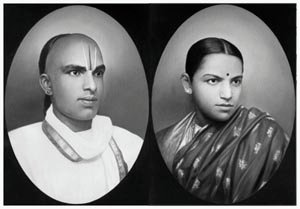
SrirangaMahaguru - Srimatha Vijayalakshmi
Marriage 1933
He disclosed to his cousin at a later period what he had seen and how it had impressed him. We quote him; 'Look at this (i.e. the picture of Lord Venkateshwara). I kept this image in my mind steadily. As the meditation progressed, the image began to disappear. And finally what I saw with my inner eyes was a heap of light. It was all light, its effulgence was, I may say, as great as that of a thousand suns. It was in fact an ocean of radiance. You might even say that it was as bright as a billion billion suns'. For a week after this realization, he told us, he had extreme difficulty in taking any interest in worldly matters. He had great ado in engaging his mind in day-to-day affairs.
Once the portals of Atman knowledge were set ajar, they continued to open wider until at last the barriers completely disappeared, and he could enter into the inner world at will. We believe that this explains the secret of the power of the Supreme which flowed out through him in subsequent year like a huge flood.
Mastering the Vidyas (Learnings) and the Kalas (arts)

Sriranga Mahaguru - Srimatha Vijayalakshmi
Among the subjects which he so studied were the Vedas, the Upanishads, the Brahmasutra, Yoga, the Epics, the Puranas, Tantras, Agamas, Dharmasastras, Sangeetha (music), Ayurveda, Natyasastra, Nadisastra, Arthasastra and various other related subjects. In regard to the practical sciences, he always concentrated on how he could put them to actual use. More often than not, they are generally mere subjects of study and discussion unrelated totheir practical relevance and at the same time are viewed as mutually exclusive. In Sriranga's mind they all stood arranged in a grand pattern, supporting and interpreting one another. His Yogic fulfillment played a crucial role in this and he strengthened it by extensive studies. The Mysore Oriental Library provided him with books on a wide array of those subjects. His intelligence, memory and youth stood him in good stead in this great venture. By merely glancing at a book, he not only understood its essence but could remember the most important sayings in it chapter-wise and page-wise. He could recall at will where else they occurred and inter-relate them with other similar sayings else-where and judge them with reference to their underlying themes and truths. His wide knowledge was such as to make even scholars marvel at its accuracy. His mind automatically rejected whatever was inconsequential.
A few years later when he had returned to Hedathale, he continued these studies and researches in an atmosphere which was free from noise and disturbance. We shall briefly indicate the uniqueness of his achievement with reference to three or four of them.
We must mention music first for it was the subject in which his genius shone forth in all its brilliance and the one in which he attained divine heights. Before long he could not only sing in a masterly way but had even composed some exquisite pieces himself. He also selected verses from such classics as Gita Govinda, Krishna Karnamrita, Purandara Dasa and so forth besides several others from scriptural literature including the Sharadatilaka and set them to music and sang them with great fervour and feeling. He had a moving and powerful voice which cast a spell over his listeners.
He was a meticulously thorough artist. He used to bring about a wonderful fusion between the literary and musical parts of what he sang. Pronunciation of the sounds, meaning, feelings and emotions all occupied a high place in his singing and the Swaras and the Ragas shaped themselves in such a way that they brought out the full meaning of the compositions without becoming in any way subordinate to literature. His singing of 'Shringaram Kshitinandana Viharane' was superb it is a quatrain which sings of eight different Rasas (sentiments) centred in the person of Rama, each line accounting for two of them. The sentiments are love, heroism, compassion, marvelous, comedy, aversion, fierceness, and peace. As Sriranga sang it and rendered it, the essence of each one of the Rasas became fully realized in the heart of the listener. While his singing of the Hasya portion caused comedy to assume a delightful form, that of fierceness set the heart throbbing with fear. But from it the transition to that of serenity towards the end of the last line poured the balm of peace on the frightened soul and elevated it to a divine state of tranquility such as could be known only to a sage and contemplative soul.
Achieving absolute fusion between music and sentiment was an important aspect of Sriranga's singing. But he was not a mere musician. He was a fulfilled Yogi who had explored the hidden secrets of the Pranava which is the ultimate source of Indian music. It is the same as Kundalini or the divine serpent power from which, according to the Yogasastras, Nadabrahma is born. Indian tradition sets the realization of Nadabrahma as the highest goal before a musician. It is from it that the seven Swaras (notes) take their origin, which in their turngive rise to a multiplicity of Ragas. These Swaras are heard by a Yogi in the depths of his inner being in a pure and natural state.
These divine sounds were mingled with his voice when he sang, and therefore his music had a quality rarely come across in human singing. Sriranga was a master of Devagana and he employed it on many occasions in conjunction with Diksha to prepare, purify and elevate his disciples.
He was a meticulously thorough artist. He used to bring about a wonderful fusion between the literary and musical parts of what he sang. Pronunciation of the sounds, meaning, feelings and emotions all occupied a high place in his singing and the Swaras and the Ragas shaped themselves in such a way that they brought out the full meaning of the compositions without becoming in any way subordinate to literature. His singing of 'Shringaram Kshitinandana Viharane' was superb it is a quatrain which sings of eight different Rasas (sentiments) centred in the person of Rama, each line accounting for two of them. The sentiments are love, heroism, compassion, marvelous, comedy, aversion, fierceness, and peace. As Sriranga sang it and rendered it, the essence of each one of the Rasas became fully realized in the heart of the listener. While his singing of the Hasya portion caused comedy to assume a delightful form, that of fierceness set the heart throbbing with fear. But from it the transition to that of serenity towards the end of the last line poured the balm of peace on the frightened soul and elevated it to a divine state of tranquility such as could be known only to a sage and contemplative soul.
Achieving absolute fusion between music and sentiment was an important aspect of Sriranga's singing. But he was not a mere musician. He was a fulfilled Yogi who had explored the hidden secrets of the Pranava which is the ultimate source of Indian music. It is the same as Kundalini or the divine serpent power from which, according to the Yogasastras, Nadabrahma is born. Indian tradition sets the realization of Nadabrahma as the highest goal before a musician. It is from it that the seven Swaras (notes) take their origin, which in their turngive rise to a multiplicity of Ragas. These Swaras are heard by a Yogi in the depths of his inner being in a pure and natural state.
These divine sounds were mingled with his voice when he sang, and therefore his music had a quality rarely come across in human singing. Sriranga was a master of Devagana and he employed it on many occasions in conjunction with Diksha to prepare, purify and elevate his disciples.
Nadisastra He rediscovered the ancient Nadisastra which has now been forgotten and has fallen on evil days. Of course, it is not the same as 'pulse' as understood by the modern doctor. According to this science, there are three pulses namely Vata, Pitta and Sleshma each of which records faithfully the changing conditions of body and mind. The movements of all of them are indicated with the help of the motions of birds and insects. It requires extreme intelligence to identify the minute movements which appear in all the three Nadis. Sometimes, they are so involved that nothing but the most intelligent and sensitive mind can recognize them. Sriranga mastered this most subtle and most difficult of sciences without any external guidance or help. He could do so because he was naturally equipped to do so.
Literature too received his earnest attention during this period and he acquired a commendable knowledge of both Kannada and Sanskrit literatures. He conducted lessons on Kalidasa's Abhijnana Sakuntala and some of his disciples took notes of what he taught on those occasions. They would have seen a valuable contribution to the critical literature on the drama but were unfortunately lost in transit. He did compose a laudatory poem "Shrimannalvadi Krishna Raja Mahima" describing the beauties, land-marks and characteristic traditions of princely Mysore under Krishna Raja Wodeyar IV. Though it appeared to glorify the king, the poet himself had Lord Krishna in his mind; a fact to which he gave significant expression while reading it melodiously. His forays into the epics of Ramayana and Mahabharata were numerous, and the literary sense he possessed is fully brought out in the talks that he gave on them. He could speak on any literary topic giving his listeners simultaneously enjoyment on the one hand and enlightenment on the other.
His Appearance
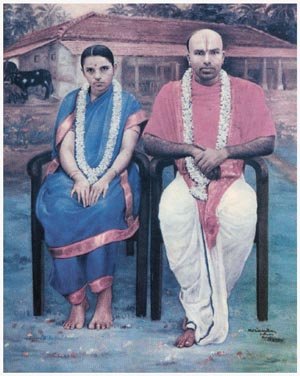
Sriranga Mahaguru
Srimatha Vijayalakshmi
Painting
A few words on how he looked like during the prime of his youth. He was of medium height. He was broad-shouldered and slim-waisted. He had strong and powerful arms, and his thighs and calves were proportionate to the rest of the body. His hands and feet and fingers and toes were all exceedingly well made. His wrists were broad and handsome and were so shaped as to draw the on-looker's particular attention. His ears were well-shaped and so was his nose. His eyes were not large but full of intelligence, tenderness and love. His gait was royal. He was wheat-complexioned. His body and its parts were so well-proportioned, so symmetrical and so well-shaped as to be a model of ideal physiognomy.
In Hedathale (1939 to 1969)
After returning to Hedathale, Sriranga gave as much time as was necessary to supervise the agricultural operations and spent the rest of his time in giving a practical shape to the works which were so near and dear to his heart. In fact, he worked for them night and day. Like the wind which blows ceaselessly and like the river which flows continuously, he strove to fulfill his high and noble objectives.
The Yogavidyopasakas (Practitioners of yoga)
(1)Sriranga
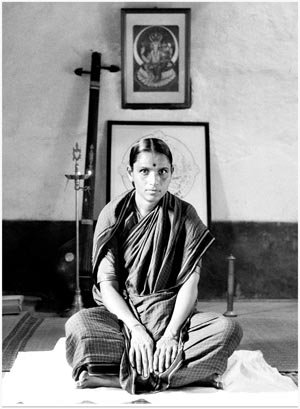
Srimatha Vijayalakshmi - 1956
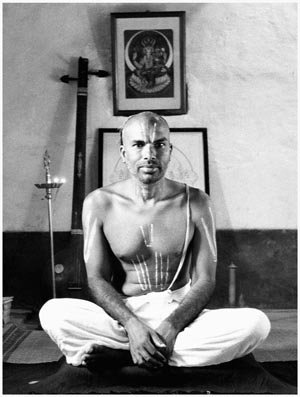
Sriranga Mahaguru - 1956
When we remember the fullness and perfection with which the knowledge of Yoga Vidya manifested itself in Sriranga it seems no exaggeration to call him Yogeshwara, the Lord of Yoga, a title which is generally reserved for Lord Krishna. Others attain Yoga by their Sadhana. But he was one who came to this world from the land of Yoga to bring to it the message of what Yoga is and what it really stands for. Therefore the word Sadhaka does not seem to be appropriate to him. He could enter into the world of yoga at any time without let or hindrance, and the radiance, blessedness and memory of that world showed itself through him at all times. After waking from sleep in the early hours of the morning, he would remain in the state of Ajadyanidra (sleep that is no inertia) for a considerable time and then would return to that of wakefulness. We used to stay with him during our vacations, and many memories of the times we were with him rush back to our mind. As we sat near him either writing or reading, we would on looking towards him, catch glimpses of his inward immersion. We would see shades of light and bliss appear on his face. On many of those occasions the true meaning of the verse of Shankara that "Yoga is neither life nor death but a strange state" used to strike our mind. One day we sat at one end of the room reading something. He sat in the centre of the room facing north. We happened to turn our eyes towards him. We saw that his right palm was held open before him and that he was gazing at a bright jewel which lay in it. This continued for a few minutes and then gradually his eyes opened and the posture of the hand changed and the jewel disappeared. Then we told him of what we had seen. He said "Yes, true. Sometimes I am given to seeing it". He was the best illustration of the Gita verse (the Yogi wakes up in the world which is utterly unknown to ordinary beings). We were afraid, or rather hesitant, to touch him on such occasions, knowing of our impurities and short-comings. We touched him only when he said. "Touch me. Examine the Nadis". Of course, we would see very distinctly when he was sleeping and when he was in a state of Yoga. Even now many memories of the occasions when he sat holding the Chinmudra in his right hand are imprinted upon our mind. Sometimes, other gestures like that of Abhaya (fearlessness) used to manifest themselves in his hand. This was specially so in the gatherings of the members of the Mandiram during Sammelanas and other special occasions. When he entered into Samadhi, radiant light, compassion and indescribable peace used to appear on his face. His presence, look and blessings were sufficient to enable anyone to cross the ocean of birth and death.
(2)Vijayalakshamma
The same Yoga manifested itself in all its grandeur in his wife, Vijayalakshamma, also. We would say that India has not seen such a Sadhaki in its long spiritual history. Within a short period of three months of receiving Diksha from her husband, she had reached the goal of Yogavidya. After that, though she was pursued by ill-health, she did her Sadhana night and day and took a firm hold of the spiritual wealth which had been given to her. Wherever she sat, she used to forget herself in Dhyana. All the characteristics of Yoga Samadhi used to manifest themselves in her person with unmistakable clarity. As she sat in Dhyana Sriranga who was conversant with her all her inner states and experiences used to explain them. On those great occasions, the science of Yoga could keep back no secret of hers from our gaze and penetration. When she entered into Yoga, all her connections with the outer world used to be completely snapped. That is so even now. She cannot perceive or remember anything that happens around her. Sriranga also used to remain in a state of complete union with the Atman. Such occasions occurred frequently. Yet, generally, even when he sat in deep meditation, Sriranga used to be not without the awareness of who was present and what was happening around him.
When Sriranga was there to explain the inner and outer conditions of the state of Yoga that manifested themselves in her, we could see in a flash the entire science of Yoga coming out from its hiding in the cave of the heart and showing its sublime truths to the eyes of mortal men. Her body used to become stark and stiff answering to the description; "the body becomes wood-like". The Vaishnavi Mudra used to appear on her face. It is a Mudra in which the eyes are wide open but wanting in the quality of external vision, for they will be seeing the great Truth inside. They also do not wink. The description given in the Sastras of it is a static one. But we learnt from her that this is only an incomplete account of the Mudra. For, it has many minute variations which are marked by differences in sight and gesture. It becomes the means of realizing different divinities in the hair-minute nerves of the heart. These have their own distinct Bandhas and Mudras. Ultimately the Vaishnavi Mudra ends in the transcendental state in which the Yogi has a marvelous realization of the Supreme Atman. This supreme state imprints itself upon the body and its organs, bringing divine peace and bliss surpassing into being in the Yogi. The credit of achieving this rare condition of Yoga goes to Vijayalakshamma. This she could achieve because, like her husband, she too had come to this world from the divine land of Yoga, and she could achieve the highest consummation of the same.
Diksha
From the beginning, Sriranga had thought that it was possible to make others also realize the Yogic state which had manifested itself in him. He decided to help others to realize it. It was natural for him to do so because he was full of compassion. It was this which had made him conduct research into the modalities of giving Diksha to others. We have already seen now he conducted his first experiment on his wife and how she had responded to it positively by reaching the goal within a short period of time. After that he had intended to open up this path in some of his friends and kinsmen. He gave them Diksha, thereby showering upon them the compassion of God. Just as from one lamp many others are lighted, similarly using them as the media he blessed, in course of time, hundreds of persons by giving Diksha to them.
The great Guru who had realized Atmasamadhi gave this Diksha only where the impulsion came from the Atman himself. Where it was not forthcoming he did not try to give it however much he might have wished to do so on account of reasons of affection or kinship. Among those who received his compassion were men and women, old persons and young boys and in a few cases even infants, able and not able persons, and healthy persons and unhealthy ones. He did not give them Diksha after enquiring into their competence or otherwise. He did not take into account their good or bad qualities. On the contrary, he saw their inner selves, and willing that they should attain jnana (knowledge), he opened up the path of Yoga in them. Becoming one with the supreme power which is the source of Yoga and which is also its ultimate goal and which impels the universe, impelled by it, he gave the Diksha. Reaching the highest state of Dhyanayoga and becoming one with the Supreme Light that the Atman is, showering through his eyes its bliss and Amrita (nectar), he gave Diksha. Becoming one with the Light that the Prananva is, and uttering the divine sound of the same, he opened up in them the path of Atman Knowledge which had become choked. In a divine and immortal moment he led them on to a path that would help them lift their souls above birth and death.
Through Ramakrishna Gurudasa, the compassion of God flowed towards the students of the school, and subsequently it extended to their parents and relatives also. Whole families became recipients of divine grace and compassion. The men and women, displaying commendable faith and devotion towards the Guru, sought refuge at his feet. It became a favourable ground for sowing the seeds of jnana.
Speaks Through Pictures
Vidyadipastambha or the Light-Pillar of Knowledge, the Sudarsana Mahamudra, Nataraja, Natya-bharati, Sanatana Arya Bharata, and Mahatpada Vinyasa pictures. They all enshrine in them great wealth of meaning and are comparatively simple. But those of Parthasarathy, Keshava Tandava, Sarvadevatamaya Sadguru are more complicated.
Sangeetha Vidya and Ganayogi
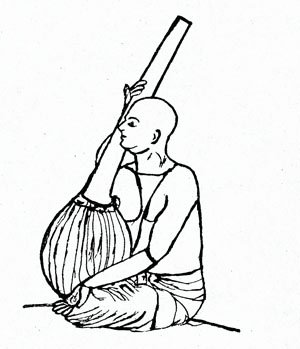
Ganayogi
His great and exalting musical renderings of Bhajagovinda Stotra, Pandurangashtaka, Narmadashtaka, Shatpadi Stotra, Ardhanarishwara Stotra, Sharadanavaratnamalika and several others, all of them Shankaracharya's compositions. Bhagavanmanasapooja, also of Shankaracharya, belongs to a later period. He set to music the ecstatic songs of the Tamil Alwars, the verses of the Ramayana of Valmiki and Tulasidas and some others. And he had hundreds of musical pieces in his collection. His disciples came continuously to visit him. And according to their needs and requests he sang to them, satiating their bodies and minds with his divine and mellifluous music. When anyone came for the first time, he tested him through his music.
There was nothing in these musical compositions which was not perfect in all the ways that count in music and was not of the highest quality. Subject, feeling, note, a high sense of propriety were all so combined in them that they were blemishless master-pieces. Even when he sang continuously for long hours-often for three to four hours-his voice did not lose its natural verve and his feelings and emotions poured themselves out in one continuous stream. In these devotional songs every word and every letter was important to him. He was a past-master in making the feelings and emotions manifest themselves through the right tone and voice. And he used to achieve absolute unity with the subject of his song. Sharada-navaratnamalika was a beautiful example of it. As he sang this devotional song becoming completely one with the Devi, her form, her beauty, size, colour, the form and length of the Veena on her lap, and her divine play upon the Veena all used to be reflected in the singing of Sriranga. The concrete images turned into sound patterns in an incredible way and filled the hearts of the listeners with joy.
From that point of view, the Bhajagovinda Stotra of Shankaracharya was one of his musical master-pieces. The Stotra throughout revealed the presence of Govinda whom Sriranga had realised in his heart. That his voice touched Govinda and was in contact with him was obvious to the listener from the first to the last stanza. In the state of such a union the voice tends to go inward and become stilled. To reach that state of Samadhi and yet to bring out through one's voice the joy, the bliss and the peace which belong to it was no mean achievement. While the song produces the feeling of the continuous presence of the divine in the singer, it also brings out the various worldly emotions which are alluded to in the Stotra with an artistic perfection which is simply matchless. This composition has many examples of sound bringing out the meaning by its very modulation.
He gave great pleasure to the senses of his listeners by his singing. And at the same time, he exalted their minds to great spiritual heights. He often caused states of Yoga to appear in them through his divine music. He purified their inner beings and made it thereby easier for them to walk on the path of Yoga. He had attained union with the Pranavanada, and it was natural that he achieved in the field of music an all-round perfection that others cannot even dream of.
Ideal Man
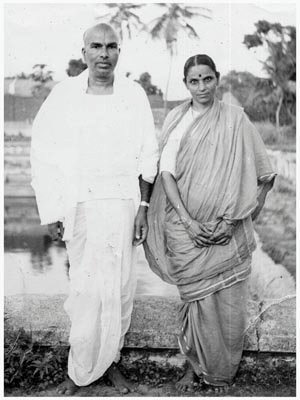
Sriranga Mahaguru
Srimatha Vijayalakshmi
1964
He possessed all noble qualities: "He spoke first and he spoke sweetly". If some one did even a small help, he was grateful for it and did not forget it. We have observed this trait in him on many occasions. He did not eat anything without sharing with others. Foul words never escaped from his lips. In his life all sorts of hardships came to him. Any other person would have broken down under them, but he bore them with natural dignity and equanimity. He was merciful by nature and was ever ready to help others. His wife too was of the same mind.His disciples came in streams, as it were, to meet him. All the responsibilities of feeding them fell upon her. Neither he nor his wife even once expressed or showed either the physical hardship which it entailed or the expenses it involved. People who came to their house left happy. We do not find anything more worthy of remembering than this hospitality which they extended to their disciple-guests. In this, Of course, He continued the traditions of the family; only he took them to a higher level of perfection.
A yogi is said to be a Nishkarmi, one who doesn't or need not do any religious rite or ritual. Sriranga knew the inner secret of the rites and rituals which are traditionally parts of a Hindu's life. He also knew that they find their fulfillment in Jnana, spiritual knowledge. So he used to perform them with great zest and enthusiasm. So with the traditional festivities of which he knew the meaning well.
He had a generous mind which showed itself in his attitude towards other religions. He was free from bigotry and invariably saw the good that is there in all religions. And consequently, to be with him, itself used to be a source of enlightenment. There were not a few among his disciples who didn't improve their outlook upon life and things by coming into contact with him.
One notable trait in Sriranga's character was that he was absolutely free from the greed for money, power etc., which marks the modern man. He had supreme command over various arts like music. It never occurred to him to barter away any of them for money etc., nor did he go in search of anybody's favour. He lived a completely independent life. In this he was true to our great cultural tradition which preaches that the Vidyas and Kalas should be pursued in and for themselves and not for any profit to be got out of them. This disinterestedness of Sriranga was one of the most commendable aspects of his life and personality. He was the embodiment of contentment.
No wonder if he inspired in his disciples a profound devotion as much because of his noble qualities as by his spiritual attainments. He was the great guru who had in a moment of upsurge of divine power and compassion opened the long locked-up path of realization in them. Therefore, they considered him not as a man but as the supreme lord in human form.
He showed that what our scriptures say of the Atman is all based upon fact, practice and realization. He showed us the way of growing great with the Atman. He showed us the way of improving our lives and actions in consonance with the highest truth. He told us that we need not remain thirsty amidst a mirage of our own making, and showed us the path to the pure waters of the Ganges of life. Today our culture, civilization and philosophy are all groping in the dark for want of light; he showed where that light is and how to realize it. In life nothing is so important as being led to where the light of life is, where the water of life is. This is what Sriranga did, no small task for any individual. He showed that it is in the space of the heart, and showed many how to reach it.